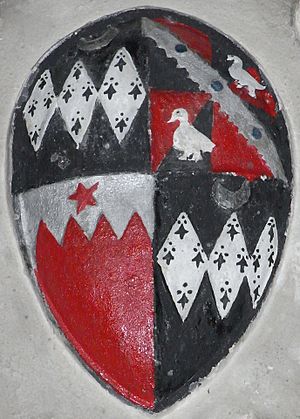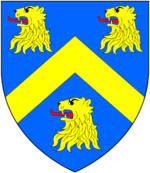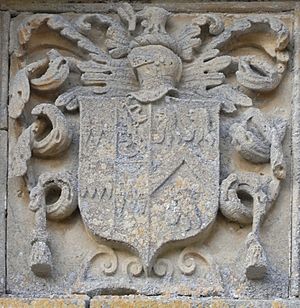John Giffard (1602–1665) facts for kids
Colonel John Giffard (1602–1665) was an important leader during the English Civil War. He was from Brightley in Devon, England. John Giffard was a Royalist, meaning he supported King Charles I.
He led the Devon Pikemen soldiers at the Battle of Lansdowne in 1643. In this battle, his cousin, Sir Bevil Grenville, a Royalist commander, was killed. Because of his strong loyalty to the King, John Giffard was considered for a special award called the Knights of the Royal Oak in 1660.
A famous writer named John Prince knew John Giffard personally. Prince included him in his book Worthies of Devon, which featured important people from Devon. John Giffard was buried in Chittlehampton Church. You can still see a small statue of him kneeling there. It is part of a monument he built in 1625 for his grandfather.
Contents
Family and Early Life
The Giffard family of Brightley was a branch of the Giffard family from Halsbury in Parkham, Devon. The Giffard family in Devon first lived in places like Weare Giffard, Awliscombe, and Halsbury.
John Giffard was the oldest son of Arthur Giffard (1580–1616) and Agnes Leigh (died 1625). Agnes was the daughter of Thomas Leigh from Burrough in Northam. John's father, Arthur, died before his own father, John Giffard (died 1622). This meant that Colonel Giffard inherited everything from his grandfather.
John Giffard had a younger brother named Arthur (1605–1666). In 1643, Arthur became the Rector of Bideford. He was appointed by their cousin, Sir John Granville, 1st Earl of Bath. However, Parliament's supporters forced him out of his church role during the Civil War.
According to the writer John Prince, John Giffard received a "virtuous and liberal education." This means he was well-taught and grew up to be a very skilled gentleman.
Marriage and Children
In 1621, John Giffard married Joan Wyndham. She was the daughter of Sir John Wyndham from Orchard Wyndham in Somerset. His father-in-law was a strong Royalist. This connection helped convince John Giffard to join the King's side in the Civil War.
After the war, John Giffard told Parliament that his relatives had influenced him. After the King returned to power in 1660, John Giffard and his wife had their portraits painted by Sir Peter Lely.
John and Joan had eight daughters and three sons. Their oldest son and heir was John Giffard (1639–1712). He married Susannah Bampfylde in 1666. She was the daughter of Sir John Bampfylde, 1st Baronet. Their oldest son was John Giffard (1668–1704).
After Susannah died in 1670, John remarried in 1674 to Frances Fane. Her father was Rev. Hon. William Fane. Frances was also the niece of Rachel Fane, who was married to Henry Bourchier, 5th Earl of Bath. This Earl was John Giffard's neighbor. John Giffard served under him at the start of the Civil War.
John Giffard's other sons were Roger (1646–1724) and Henry (died 1658). Roger inherited the old Giffard family estate of Halsbury. This happened because his distant cousin, John Giffard of Halsbury, had no male children who survived.
One of John Giffard's daughters, Grace, died in 1667. Her statue can still be seen in Chittlehampton Church. Another daughter, Agnes, married Thomas Bere, who was the lord of the manor of Huntsham.
Land and Property
On October 14, 1638, John Giffard bought the title of lord of the manor of Chittlehampton. He bought it from Sir Lewis Pollard, 1st Baronet. This made him the first recorded resident lord of that area.
Records from his manorial court survive for 1640 and 1641. These records show that he owned the manors of Brightley, Chittlehampton, Stowford, and Snape. He also owned Tapeley and Halsannery.
The court records, written in Latin and English, show rules for his tenants. For example, tenants had to repair a "cucckinstoole" (a ducking stool), a chimney, a "lynney house" (a farm building), and a "rooke nett" (a net for catching rooks).
Role in the Civil War
At the start of the English Civil War, John Giffard was chosen as a Commissioner of Array for Devon. He worked under his neighbor, Henry Bourchier, 5th Earl of Bath. His job was to help raise troops for the Royalist side. This was not a popular task.
On September 13, 1642, Giffard and other commissioners went to South Molton. They wanted to read their commission to the townspeople. However, a large, angry crowd of over 1,000 people met them. The crowd had weapons like muskets and clubs. They threatened to kill the commissioners if they tried to recruit anyone. So, Giffard and the others had to leave South Molton without any new soldiers.
Around September 23, 1642, Hopton, a Royalist general, stayed at Chittlehampton with his cavalry. About 400 of his men stayed in the parish. It is possible that Giffard joined Hopton as he marched on. Giffard was not at a Royalist gathering in December 1642. Some said he stayed away from Brightley to avoid the cost of hosting.
During the Civil War, John Giffard became a Colonel. He led the Devon pikemen at the Battle of Lansdowne on July 5, 1643. This battle was near Bath. He fought alongside his cousin, Sir Bevil Grenville, who died bravely leading the Cornish pikemen.
After a Royalist defeat in 1644, Giffard said he "retired to live privately." However, at that time, 300 Royalist cavalry soldiers were stationed at Brightley. Parliament's cavalry watched them closely from Brightley Bridge. John Giffard's brother, George, asked their cousin Walter Erle for advice on how John could surrender to Parliament.
He was advised to surrender as soon as possible. After the Royalist soldiers left Brightley, Giffard quickly asked for protection from Sir Thomas Fairfax. Fairfax was the commander of Parliament's forces.
When the Commonwealth government was set up, Giffard's property was taken away (this was called sequestration). He was also imprisoned. To get his property back, he had to pay a large fine, called a composition, of £1,136.
He sent a "humble petition" to Parliament to explain his actions. He said that relatives had convinced him to fight against Parliament. He also claimed he "did not clearly understand what was happening." He said he only did what was needed to protect himself, his wife, and his children. These relatives were the Wyndhams (his wife's family) and the Grenvilles.
However, the people of Chittlehampton disagreed. Twelve parishioners, who supported Parliament, sent their own petition. They called Giffard "a violent and active enemy to the state." They said he had caused them and others losses worth thousands of pounds. They wanted his estates to be taken away permanently.
Despite this, the local Parliament Commissioners for Devon accepted Giffard's petition. They allowed him to pay the fine of £1,136. This amount was three times his yearly income.
After the Restoration of the Monarchy in 1660, King Charles II chose Giffard as one of fourteen proposed Knights of the Royal Oak from Devon. This honor was meant for those who supported the King during his exile. However, the award was never officially created.
Death and Burial
John Giffard died in 1665 at Brightley. He was buried with his ancestors in Chittlehampton parish church. His image, a kneeling figure, is still on the monument he built in 1625 for his grandfather. In his will, he left £1,000 to each of his five unmarried daughters.
John Prince's View
The Devon writer Rev. John Prince (1643–1723) knew the Giffard family well. He had worked under John Giffard's brother, Arthur, in Bideford. Prince included John Giffard in his important book Worthies of Devon.
Sources
- Andrews, Rev. J.H.B., "Chittlehampton", Transactions of the Devonshire Association, vol.94, 1962, pp. 233–338.
- Andriette, Eugene A., Devon and Exeter in the Civil War, Newton Abbot: David & Charles, 1971.
- Prince, John The Worthies of Devon. A new edition, with notes. London, 1810.
- Vivian, Lt.Col. J.L., (Ed.) The Visitations of the County of Devon: Comprising the Heralds' Visitations of 1531, 1564 & 1620. Exeter, 1895.




